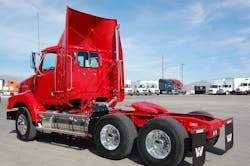Despite strong order volume in December last year, commercial truck sales are expected to decline in 2016 and as a result OEMs continue to cut back on factory staffing.
Daimler Trucks North America (DTNA) is the latest truck maker to reduce headcount announcing plans to lay off 936 workers at its manufacturing plant in Cleveland, NC, on Jan. 8 – a plant that builds heavy-duty Freightliner and Western Star trucks – though David Giroux, DTNA’s director of corporate communication and public relations, noted in a media statement that this layoff is “considered temporary.”
"DTNA is reducing output by one-third at the Cleveland Facility in anticipation of a softer North American truck market in 2016, which will be somewhat below the very strong market of 2015,” he added.
Volvo Trucks is another truck maker that has reduced headcount in the face of falling Class 8 orders, laying off 734 workers at its Dublin, VA, plant last month.
Though Kenny Vieth, president & senior analyst with ACT Research Co., noted that Class 8 and Class 5-7 truck orders were very strong back in December compared to November, they did not fare so well in year-over-year comparisons.
ACT said North American Class 8 net orders topped 28,100 units in December – up 68% compared to November’s weak tally, and the best order volume since February.
Yet Veith also noted that Class 8 orders were down 26% compared to December 2014, marking the ninth consecutive month in which industry orders fell below year-ago levels.
Strong North American orders continued for Class 5-7 trucks in December, reaching 21,600 units and marking the third time in the last fourth months they’ve exceeded the 20,000 unit mark – a feat last accomplished in mid-2006, Vieth said.Yet while Class 5-7 orders were up 15% compared to November, December’s order volume was down 5% compared to December 2014.
He explained to Fleet Owner in an interview last month that “you can almost set your watch” to truck order cycle peaks and that they “sadly end the same way every time” with falling demand.
“We just thought the U.S. economy would stay stronger, longer,” Vieth noted. “We thought truck orders would stay strong through 2015 and into 2016 and that would not begin to see a real decline in orders until the second half of 2016.”
Michael Baudendistel, VP with the Stifel Transportation & Logistics Research Group, added that this “rebound” in orders is a reassuring signal that production should not fall off a cliff in 2016, though it does not indicate that truck manufacturers will soon be “off to the races again” like in 2015.
“[Production] will likely still remain above or within the range of replacement demand levels despite the overbuild in 2015,” he noted in a research brief this week.
“We believe the headwinds facing the industry in 2016 are still significant and that Class 8 orders are unlikely to be sustained at the December levels as 2016 progresses,” Baudendistel pointed out. “As such, we are maintaining our 2016 Class 8 production estimate of 250,000 units – down 24% year over year – and we continue to believe Class 5-7 production will be relatively flat year-over-year.”
Some U.S. economic activity – particularly manufacturing – dipped at the end of last year. According to the Institute for Supply Management (ISM), economic activity in the U.S. manufacturing sector contracted in December for the second consecutive month – registering 48.2%, a decrease of 0.4 percentage point from the November reading of 48.6%.
“As was the case in November, 10 out of 18 manufacturing industries reported contraction in December,” noted Bradley Holcomb, chair of the ISM’s business survey committee, in a statement. “Contraction in new orders, production, employment, and raw materials inventories accounted for the overall softness in December.”
Globally, Maury Obstfeld, the new chief economist for the International Monetary Fund (IMF), noted in a statement this week that “the mood in financial markets is glum as 2015 ends, and susceptible to increased volatility, notwithstanding continuing accommodation by the European Central Bank and the Bank of Japan.”
He added that “it will be critical” how the U.S. Federal Reserve manages its planned series of gradual interest-rate hikes – the first of which occurred in December – a task Obstfeld said the Fed “seems to have commenced on the right foot” at the end of 2015.
“But there is no doubt that global financial conditions are tightening, and emerging and developing markets are especially sensitive to the effects, given other current woes,” he pointed out.
About the Author
Sean Kilcarr
Editor in Chief
Sean Kilcarr is a former longtime FleetOwner senior editor who wrote for the publication from 2000 to 2018. He served as editor-in-chief from 2017 to 2018.

